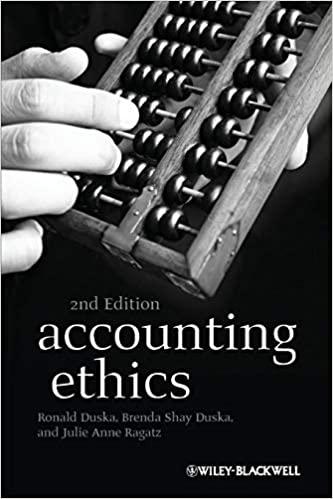Answered step by step
Verified Expert Solution
Question
1 Approved Answer
Accounting 311 In class #1 Based on Case 5-64 in text 5-64. Cost Estimation, CVP Analysis, and Decision Making (LO 5-4.5.8) Luke Corporation produces a



Accounting 311 In class #1 Based on Case 5-64 in text 5-64. Cost Estimation, CVP Analysis, and Decision Making (LO 5-4.5.8) Luke Corporation produces a variety of products, each within their own division. Last year, the managers at Luke developed and began marketing a new chewing gum, Bubbs, to sell in vending machines. The product, which sells for $5.25 per case, has not had the market success that managers expected and the company is considering dropping Bubbs. The product-line income statement for the past 12 months follows: Table 1 $14,682,150 Revenue Costs Manufacturing costs Allocated corporate costs (@5%)... Product-line margin.... Allowance for tax (20%)... Product-line profit (loss).......... $14,440,395 734,108 15.174,503 $ (492.353) 98,470 $ (393.883) All products at Luke receive an allocation of corporate overhead costs, which is computed as 5 percent of product revenue. The 5 percent rate is computed based on the most recent year's corporate cost as a percentage of revenue. Data on corporate costs and revenues for the past two years follow: Table 2 Corporate Revenue Corporate Overhead Costs Most recent year.... Previous year....... $106.750.000 $ 76,200,000 $5,337,500 4,221,000 Roy O. Andre, the product manager for Bubbs, is concerned about whether the product will be dropped by the company and has employed you as a financial consultant to help with some analysis. In addition to the information given above, Mr. Andre provides you with the following data on product costs for Bubbs Table 3 Month Cases 207.000 217,200 214,800 228,000 224,400 237,000 220,200 247,200 238,800 252,600 250,200 259,200 Production Costs $1,139,828 1,161,328 1.169.981 1.185.523 1,187,827 1.208.673 1,183,699 1,226,774 1.225 226 1,237,325 1,241,760 1,272,451 12. Table 4 Linear regression model for variable Cost Filters: Cost = 2.236. Units + 6.823556 Obs 12 RMSE = 7,969.9643 R2 = 0.96107694 Adjusted R2 = 0.95718464 Model does a good job explaining variation in Cost. Consider removing variables with insignificant coefficients as they may hurt more than they help. Histogram of Residuals ROC Curve 10000.01 9000.01 Frequency 0.07 5000.0 -10000.0 5000 1000 1150000 - 15000-10000-50000 Residual 1250000 1200000 Predicted Cost Significance Variable Units Constant Coefficient 2.236 6.82355 15.71 20.53 p>It 2.235E-8 1665E-9 Std Err 0.1423 3.324E4 *** Wednesd Thursday Answer the following questions. A regression analysis of the Bubbs production cost data from Table 3 is shown in Table 4. You may need the results of the regression to answer some of the questions. Carry all per case calculations to 5 decimals. 1. How many cases of Bubbs did Lukes sell (based on sales revenue)? 2. Using the high low method based on the data in Table 2 to determine the variable corporate overhead cost per sales dollar. 3. What is the variable corporate overhead cost per case? 4. Based on the high low analysis, what is the fixed corporate overhead cost per month? Round your answer to the nearest dollar. 5. Using the regression results in Table 4. what is the variable production cost per case of Bubbs? 6. Using the regression results, what is the fixed production cost per month of Bubbs Round your answer to the nearest 100 dollars. 7. What is the total variable cost per case of Bubbs? 8. What is the contribution margin per case of Bubbs? 9. What is the monthly average number of cases of Bubbs that Lukes sold last year? Round to the nearest whole number 10. What is the monthly break-even number of cases of Bubbs? Consider whether or not to include some portion of the allocated costs. Round to the nearest whole number 11. What is the fixed production cost per case based on the current average sales volume per month? Round to four decimals. 12. Reformat the Income Statement shown in Table 1 to separate the fixed from the variable costs. What is the total annual contribution margin of Bubbs? 13. What is the annual pre-tax net income from Bubbs ignoring any allocation of corporate costs? 14. What is the annual pre-tax net income from Bubbs assuming the fixed corporate costs are allocated to products / divisions based on total revenues? 15. What is the price per case that is required for Bubbs to break-even at the given volume of sales in the current year? Round up to the nearest $.01. Assume that fixed corporated costs are on the basis of Revenues as in 14. Keep in mind that increasing the price per unit will increase both the Revenues for Bubbs and for Lukes in total
Step by Step Solution
There are 3 Steps involved in it
Step: 1

Get Instant Access to Expert-Tailored Solutions
See step-by-step solutions with expert insights and AI powered tools for academic success
Step: 2

Step: 3

Ace Your Homework with AI
Get the answers you need in no time with our AI-driven, step-by-step assistance
Get Started


